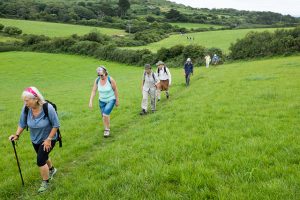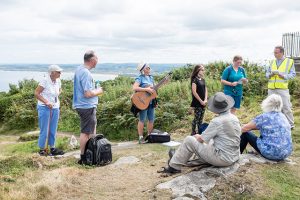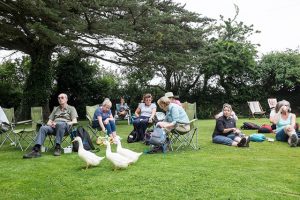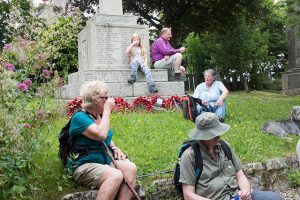Journeying along the Way
Sue Doggett recalls a pilgrimage along St Michael’s Way to mark the feast day of St James
Approximately 40 people gathered at St Uny Church, Lelant, on Saturday, July 23, to begin a pilgrimage walk in celebration of the Feast of St James. The walk was led by the Bishop of St Germans, the Rt Revd Chris Goldsmith, and Revd Nigel Marns, Rector of the United Benefice of Mounts Bay. The pilgrimage offered a Christian response to St Michael’s Way and included prayers, readings and songs as we journeyed along.
On arrival at St Uny Church, walkers were greeted with the welcoming aroma of fresh coffee and croissants and, after enjoying time to gather, chat, pray and sing together, everyone set off down the coastal path across the West Cornwall Golf course and onward towards Hawks Point.
Our first pause point was above Porthkidney Sands where, against the magnificent backdrop of St Ives Bay, we learnt about the location at Black Cliff rocks on the other side of the Hayle Estuary where St Anta had first set up her prayer cell and from which a beacon had shone out across the sea for many hundreds of years. Our reading was from John 8:12 (I am the light for the world) and we sang This Little Light of Mine accompanied by Revd Annie Holland on her guitar.
We then continued on our way into Carbis Bay, where we stopped briefly before taking the path which leads across the St Ives Road and up Steeple Lane to Knill’s Monument. John Knill built this triangular pyramid of granite on Worvas Hill. The words “Resurgam” and the Coat of Arms and his motto (Nil desperandum) is on one side, the second side bears the inscription: “I know that my Redeemer liveth,” and on the third side is inscribed “Johannes Knill 1782”. John Knill fully expected to be buried here as on one side the structure there is hollow containing a stone sarcophagus. However, he died in London on 29th March 1811 and was buried at Holborn cemetery.
At the top of Trencrom Lane we were joined by four-year-old Amy and her mum — her grandma and great grandma were already part of the group! A few miles later, we stopped for lunch at the home of Caroline and Keiren Marwood, who kindly opened t
heir beautiful garden for us and generously provided us with hot drinks, fruit and chocolate treats—a very welcome break! After lunch we sang He Who Would Valiant Be and heard the story of the giant who hurled the huge lump of granite known as The Bowl Rock from the top of Trencrom to its resting point at the head of the lane leading to Caroline and Keiren’s cottage.
On reaching the top of Trencrom, we paused to take in the panoramic view which encompasses both St Ives Bay and Mounts Bay. From this ancient granite vantage point, we could see the route we had taken so far and our final destination, St Michael’s Mount, rising majestically out of the distant sea. Reaching the National Trust car park via the rocky descent on the south side of the hill, we were joined by around 20 more ‘pilgrims’ who were waiting to travel with us on the second leg of our journey.
Our next pause point was the tiny hamlet of Ninnes Bridge which lies to the southern side of Trencrom Hill. We stood in front of the pretty little Primitive Methodist chapel (now a private dwelling) to learn about the 18th century Methodist revival under the influence of John and Charles Wesley.
The next part of our walk took us through the fields and lanes which finally led down to Ludgvan. We stopped at the picturesque ford at Boskennal before continuing up the lane to the farm where, for the first time, the tower of Ludgvan Church and castle on the mount can be seen in the same vista across the fields. It was a welcome sight, knowing that refreshments awaited us at the church!
The final leg of the journey took us through fields known locally as the ‘golden mile’, across the busy A30, the main Penzance railway line and the even busier A394, and on to the boardwalk that crosses the marshes into Marazion. As we reached the sand dunes on the outskirts of the town we were greeted by a welcome party—including Caro Woods and her Connemara pony, Tommy, who themselves had recently completed an epic pilgrimage from the Holy Island of Lindesfarne in Northumberland to St Michael’s Mount, a journey of nearly 1,000 miles.
Our final destination was All Saints Church in Marazion where each participant received a fully-stamped passport as a memento of the day. The intention was to walk across the causeway to the Mount, but the tide was against us and the Cornish mizzle had set in so we settled for a cream tea in the church, kindly provided by Tough Dough’s First Steps group who had 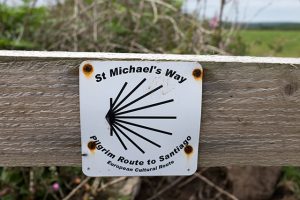 been running children’s workshops at the church to mark the occasion.
been running children’s workshops at the church to mark the occasion.
Before we departed, again we sang and prayed together. Bishop Chris asked us to think of just one part of the journey that held a special meaning for us. Amongst so many special places that mark this ancient route it was hard to choose, but, for me, the refreshing waters of Boskennal ford had offered a moment of quietude in a busy and tiring day.
